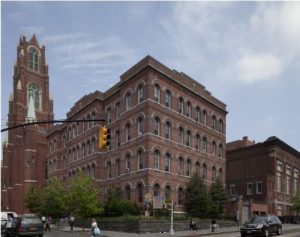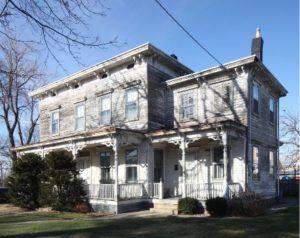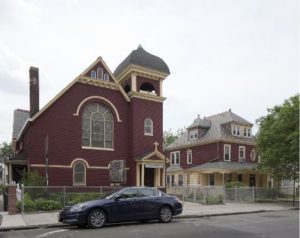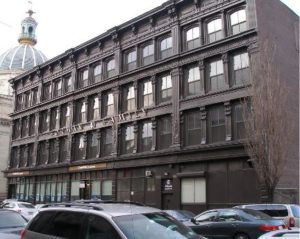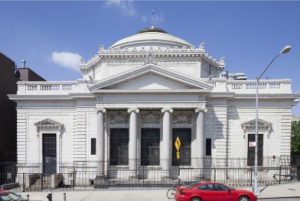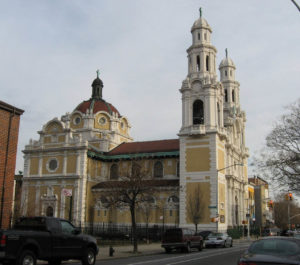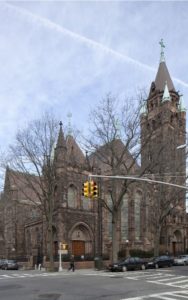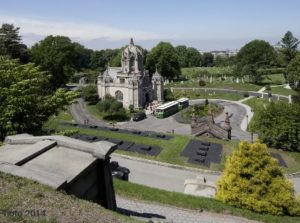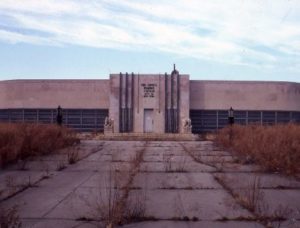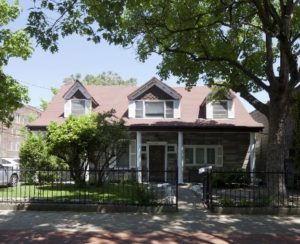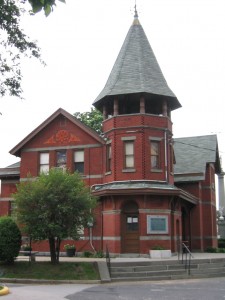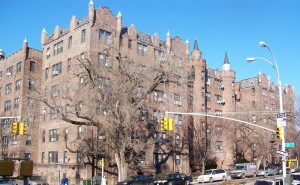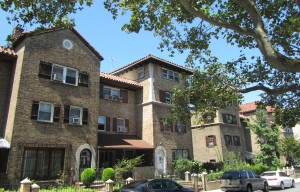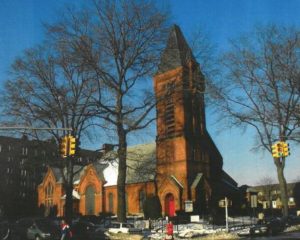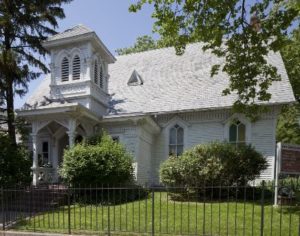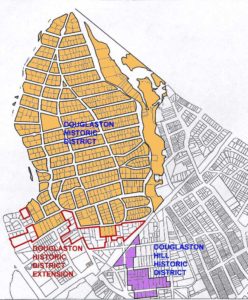The NYC Landmarks Preservation Commission has scheduled four “special hearings” this fall to consider 95 proposed landmarks that have been on the agency’s calendar for five years or more. Back in November 2014, the LPC attempted to “de-calendar” all of these items, but since agreed to let the public weigh in. Below is HDC’s testimony for the first hearing on October 8, which will cover all items in The Bronx, Brooklyn and Queens. The subsequent hearings are on October 22 (Staten Island), November 5 (Manhattan A) and November 12 (Manhattan B).
THE BRONX
Item 1-A
IMMACULATE CONCEPTION CHURCH, 378 East 151st Street, Bronx
LP-1192
Landmark Site: Bronx Block 2398, Lot 14
Individual Landmark designation of the Immaculate Conception Church is an opportunity to grace The Bronx, an under-landmarked borough, with protection of its architectural heritage. Currently, The Bronx has only three landmarked churches, none in the timeless Romanesque Revival style. This neighborhood, and the borough, has come a long way from the darker days of arson and crime. The survival of this remarkable complex throughout its history, good and bad, is a testament to its firm grounding in its community.
This church complex was conceived for a vast German population, which was the largest ethnic group in The Bronx at the turn of the century. The tripartite façade of the church building boasts four rose windows tucked behind rounded arches and clustered colonettes, and is flanked by two turrets, lending a fortress-like appearance. The warm red brick features limestone detailing, delivering a handsome polychromatic composition. Collectively, the complex constitutes a cohesive and attractive streetscape.
Through decades and waves of immigration, Immaculate Conception Church has graced the South Bronx with its beauty, and astonishingly remains intact. We urge the Commission to designate the church as an Individual Landmark. The biggest gift the church could bestow on its community a continuation of the stability it has provided for over a century in a place of constant change. Just as cathedrals are revered in Europe, structures like Immaculate Conception are our future cultural patrimony.
Item 1-D
65 SCHOFIELD STREET, 65 Schofield Street, Bronx
LP-2395
Landmark Site: Bronx Block 5628, Lot 146
HDC is pleased to have the opportunity to speak in favor of the designation of 65 Schofield Street as an individual New York City landmark. City Island is an unusual area of New York City that truly stands out as a small maritime community that has been embraced but not engulfed by the urban sprawl of the larger city. As noted in the AIA Guide to New York City, “on the streets that run perpendicular to the fishbone spine of City Island Avenue are more than a handful of distinguished older houses…65 Schofield Street, serene and peeling, seems a candidate for a Hopper painting: austere, venerable, self-confident”.
This building is a remarkable example of Italianate farmhouse design with Greek Revival elements, characterized by a square plan, tall windows, flat roof with an overhanging cornice and elaborate brackets. The building’s most striking feature is the one-story porch that runs across the width of the building. Fantastically, the main body of the house is still clad in its original wood clapboard, which serves to evoke a sense of architectural antiquity in a way much more common to small New England towns than The Bronx. Aside from its architectural integrity, research has uncovered direct connections between this building and the Pell and Schofield families, prominent families who were deeply involved with the development of City Island. This building is, frankly, an obvious landmark on all counts and should be protected in order to maintain its integrity as a visible, prominent link to City Island’s past.
We believe strongly that under the oversight of the Landmarks Commission, this building will prosper. HDC urges the Landmarks Commission to designate this handsome building as a landmark and work with these owners to bring this structure back to life.
Item 1-E
FIRST PRESBYTERIAN CHURCH OF WILLIAMSBRIDGE & RECTORY, 730-736 East 225th Street Street, Bronx
LP-1191
Landmark Site: Bronx Block 4838, Lot 66
Williamsbridge, Bronx does not have one designated historic district or individual landmark. The First Presbyterian Church is unusual and one of a kind in appearance and amidst its context, an otherwise architecturally undistinguished block. The building contains elements in a mélange of styles, including Romanesque, Colonial Revival, and Gothic, as depicted in its arched roof.
The AIA Guide to New York City describes this church as “a provincial shingle masterpiece.” The church is colored richly in red wooden shingles with yellow trim and features a square belfry crowned with an ogival roof. It also features dentilled and acanthus leaf wooden cornices. Its adjacent rectory boasts the same color and materials scheme, with an ocular window on the primary façade, which subtly nods to the flare of the church.
BROOKLYN
Item II-A
183-195 BROADWAY BUILDING, 183-195 Broadway, Brooklyn
LP-1223
Landmark Site: Brooklyn Block 2446, Lot 51
According to Margot Gayle, the premiere advocate for cast-iron architecture in New York City, the 183-195 Broadway Building is the finest surviving cast-iron building in Brooklyn. In 1979, when this building was first submitted for evaluation to the Landmarks Preservation Commission, Gayle wrote that the recent losses of two other significant cast-iron buildings in Brooklyn made the preservation of 183-195 Broadway of even greater importance. Today, more than 35 years later, the building has fortunately survived without landmark designation. Nevertheless, it remains important to designate this building to ensure its survival.
No. 183-195 Broadway was designed by Williamsburg architect William B. Ditmars in 1882. The iron elements of the building were cast by the Atlantic Iron Works of Manhattan, a company that cast pieces for many buildings in Tribeca and Soho. One of the defining features of the ornate cast-iron is an inventive use of decorative calla lilies, stylized drapery, and wreaths on the building’s pilasters. The treatment of the flowers and leaves seems to follow the Aesthetic movement and are bordering on Art Nouveau, but predate that movement by 10 years. A similar spiral floral concept can be seen on other buildings but the use of the calla lily is considered to be unique. The cast-iron façade, including the bracketed cornice and storefront elements, remains remarkably intact.
The building was likely built as a factory and warehouse for shoe dealers James R. Sparrow and his son. In 1937, the building became home to the Forman 4 Family, a manufacturer of chromium tableware and metal gift items, who for decades kept the building admirably maintained. Signage from this company still remains between the second and third floors. The building now houses loft-style apartments.
Although cast-iron buildings could once be found throughout Brooklyn, the four surviving cast-iron buildings clustered along this section of Broadway in Williamsburg are among the only survivors in that borough, and the only such substantial group in the boroughs outside Manhattan. Only one of these four is a designated landmark. Therefore, as one of the finest cast-iron buildings in Brooklyn and among the most unusual examples of the type in New York City, 183-195 Broadway is highly worthy of landmark designation. Furthermore, it recalls an era when Williamsburg functioned as Brooklyn’s secondary downtown business district, teeming with banks, warehouses, and other commercial enterprises. The building’s designation was heard five separate times on several dates from 1980 to 1990 but was never successfully designated due to owner opposition. Over three decades have passed since the first Request for Evaluation was submitted, but it remains of highest importance to designate this building to ensure its protection.
Item II-B
WILLIAMSBURG TRUST CO. BUILDING (UKRANIAN CHURCH IN EXILE/HOLY TRINITY CATHEDRAL), 177 South 5th Street, Brooklyn
LP-0163
Landmark Site: Brooklyn Block 2446, Lot 63
This structure was built in 1905 across from Continental Army Plaza, a park completed in conjunction with the construction of the Williamsburg Bridge in 1903, creating a small patch of the City Beautiful era in this otherwise gritty urban intersection. As described in An Architectural Guide to Brooklyn by Francis Morrone, “The Williamsburg Trust Company, the dome of the Williamsburgh Savings Bank, Shardy’s equestrian statue of George Washington—it is given to so few places, not only in New York but in the world, to have individual elements of such beauty in their midst, yet here these elements, so worth seeking out, are buried in steel, soot, chaos and clangor.”
The architect, Frank J. Helmle, worked in the firm of McKim, Mead and White before opening his own office in Williamsburg and partnering with architects Huberty and Hudswell. The firm’s masterpiece is St. Barbara’s Roman Catholic Church in Bushwick, which is also under consideration for individual landmark designation, along with several other Brooklyn banks including the Greenpoint Savings Bank and the Williamsburgh Savings Bank. Helmle’s later career as the Superintendent of Public Buildings of Brooklyn bestowed his gift of the Boathouse in Prospect Park, as well as commissioning 42 firehouses in New York City.
The Williamsburg Trust Company Building remains remarkably intact despite its long history of adaptive reuse. This building is one such product of development spurred by the opening of the Williamsburg Bridge, but the bank went under only 10 years later in 1915, and at that time, the building was converted to serve as the Fifth Districts Magistrates Court. When the New York City court system changed, the building was rendered obsolete for that purpose and in 1961, a Ukrainian immigrant population bought the building and has had an active congregation ever since. We urge the Commission to designate this little piece of Beaux Arts beauty at the foot of the bridge. This building has served a variety of people and uses over the course of a century, and landmark status will secure its future as the City continues to change around it.
Item 11-C
BARBARA’S ROMAN CATHOLIC CHURCH, 138 Bleecker Street, Brooklyn
LP-1201
Landmark Site: Brooklyn Block 3306, Lot 6
St. Barbara’s Roman Catholic Church is instantly recognizable from all around for its exuberant ornament and for the soaring height of its towers, rising high above low-rise Bushwick. The grand yellow brick building with white and cream terra-cotta trim was designed by Helmle & Huberty and built in 1907-10. Its elaborate exterior massing includes a grand dome and two 175-foot tiered towers, each topped by a crucifix. The church features a grand entrance bay resembling a triumphal arch, with arched openings, columns, and a rounded pediment. These classically-inspired components were a signature of the architecture firm, which was prolific in Brooklyn. The interior of the church is equally elaborate in its Baroque-inspired design, with beautiful statuary, carvings, frescoes, and stained glass windows.
Described in the LPC’s hearing statement as Spanish Mission Revival or neo-Plateresque, it is also quite likely that Helmle & Huberty were influenced by German Baroque ecclesiastical architecture, given that St. Barbara’s served a congregation comprised mainly of German immigrants in its early years. The church is said to be named for Barbara Epping, the daughter of local brewer Leopold Epping, who donated the major funds to construct the church. As previously mentioned, the church served local German immigrants, many of whom worked in the breweries in Bushwick, including Epping’s, but the congregation evolved over the years to serve the area’s changing population of Italians and, more recently, Latin Americans.
The church stands as a neighborhood anchor and a magnificent piece of architecture that many would be surprised to learn is not already protected by the Landmarks Law. We urge the Commission to designate this worthy building that, for many, is already considered a landmark, and to ensure its protection for generations to come.
Item II-D
AUGUSTINE’S ROMAN CATHOLIC CHURCH AND RECTORY, 130 Sixth Avenue, Brooklyn
LP-0150
Landmark Site: Brooklyn Block 944, Lot 41
It is astonishing that moving just a few blocks south of the sprawling mess of Atlantic Center, one finds St. Augustine’s Church and Rectory, occupying an entire block of 6th Avenue between Sterling and St. John’s Places. It is here that the some of the most beloved parts of Brooklyn begin, as described in the Park Slope designation report: “…one is immediately struck by the homogeneous quality of this street. It still embodies today the distinction that Brooklyn had, in the 19th century, as a city of homes and churches. The vista along the avenue between Sterling Place and Union Street has an understated regularity dramatically accented by the spires of two churches, St. Augustine’s at Sterling Place and St. Francis Xavier at Carroll Street.”
The Gothic Revival, High Victorian style church is known as “the Cathedral of Park Slope”. When it opened, The Brooklyn Daily Eagle declared St. Augustine Church “one of the finest examples of Gothic architecture in the country,” and later, “one of Brooklyn’s most picturesque churches.” The American Institute of Architects Guide to New York City put it best: “Sixth Avenue is one of Park Slope’s grandest streets, block after block containing rows of amazingly preserved row housing. St. Augustine’s provides an oasis along the stately avenue, both spatially and in change of scale. The crusty tower with its mottled brownstone contrasts with the smoothness of the row housing. It is one of the most elaborate and architecturally distinguished Roman Catholic churches in Brooklyn, which has as many Roman Catholic churches as Rome. Queen Victoria’s best awaits you within.”
This lauded complex is the epitome of a landmark and we urge the Commission to officially protect these structures as part of their rightful home, just steps from the Park Slope Historic District.
Item II-E
GREEN-WOOD CEMETERY, Green-Wood Cemetery, Brooklyn
LP-1233
Landmark Site: Brooklyn Block 902, Lot 1
Green-Wood Cemetery is a National Historic Landmark encompassing 478 acres, with over 500,000 graves, including those of many notable historic figures. It was the third – and remains the largest – rural cemetery established in the United States, and the first rural cemetery in New York City.
Founded in 1838, Green-Wood was designed by David Bates Douglass and described as a tour de force of the picturesque landscape. Carefully sited with dramatic views of the city and harbor, a viewshed it retains today, Green-Wood is also one of the most extensive, and among the most intact, landscapes created on the principles of Andrew Jackson Downing in New York City. The cemetery is a veritable architectural encyclopedia for its amalgam of mortuary architecture, buildings and statuary. Among the styles represented are Classical, Gothic and Romanesque. The distinctive, brownstone Gothic Revival entrance, designed by Richard Upjohn, was designated an Individual Landmark in 1966.
While no one would dispute the worthiness of this magnificent landscape, HDC feels that the designation of the entire cemetery would be burdensome to both the cemetery’s management and the Landmarks Preservation Commission. The cemetery’s plots, including headstones and mausoleums, are owned by individual property owners, which would make for onerous outreach and regulatory processes. However, the properties within the cemetery that are owned by Green-Wood, including the Chapel, designed by noted architects Warren and Wetmore as a scaled-down version of Christopher Wren’s Tom Tower at Christ Church, Oxford, as well as the gatehouses and other ancillary structures, would be welcome additions to New York City’s roster of protected landmarks. Ensuring the sensitive maintenance of the structures that set a standard for architecture in urban parks would be an important and worthwhile endeavor.
Item II-F
CONEY ISLAND PUMPING STATION, 2301 Neptune Avenue, Brooklyn
LP-1130
Landmark Site: Brooklyn Block 6965, Lot 125
The Coney Island Pumping Station replaced an older station in 1937-38. The need for a high pressure water system in this area was imminent, as it failed during a catastrophic fire along the boardwalk in 1932, and also failed at the Dreamland fire of 1911. The new station was a WPA project, and this was architect Irwin S. Chanin’s only public work, making this an unusual commission.
The architect Irwin S. Chanin is best known for impressive landmarks like the Century and Majestic apartment buildings on Central Park West and the masterpiece Chanin Building on 42nd Street. In Coney Island, Chanin was able to bring the elegant Art Moderne style to a utilitarian structure. The elliptically shaped fire pumping station is faced in limestone over a granite base and originally featured prismatic glass windows with steel surrounds.
The building still proudly stands in the center of a large grassy plot and originally had complementary symmetrical plantings. Three wide, cement walks still lead up to the pump house from the streets, and paired statues originally flanked the entrance. These Art Deco pieces of art adorned the otherwise utilitarian industrial building and feature Pegasus, symbols of Neptune, atop stylized waves and clouds. The sculptures remain safe at the Brooklyn Museum, where they remain to be returned to their landmark. The survival of these original decorative elements supersedes the removed windows, which is the largest alteration to this building.
This building’s deserves landmark designation because of its unusual city commission of Irwin S. Chanin as an example of his only public work; is an outstanding example of Moderne industrial architecture; contributes to the history of fire fighting and Coney Island; and survives as a gem in a part of Brooklyn where there is a dearth of architectural pedigree.
Item II-G
LADY MOODY-VAN SICKLEN HOUSE, 27 Gravesend Neck Road, Brooklyn
LP-1130
Landmark Site: Brooklyn Block 7123, Lot 64
The Lady Moody-Van Sicklen House is a rare surviving example of Brooklyn’s agricultural past that deserves recognition as a New York City landmark. This property is part of Kings County’s agricultural history, a history that was a crucial component to the success of New York City. Today there are less than a dozen examples of these farmhouses remaining. Located at 27 Gravesend Neck Road, the Lady Moody-Van Sicklen House is not only “a rare surviving example of an eighteenth-century Dutch-American farmhouse” it is “the only known extant 18th century farmhouse of stone construction in Brooklyn.” (LPC 2004)
Built partly of rough stone, the Lady Moody-Van Sicklen House stands on its original siting on ground that was originally part of the northwest square of Gravesend. In addition to the stone walls, the house features a gable roof with wide, overhanging eaves and an end chimney typical of 18th century Dutch-American farmhouse construction.
The house is believed to have belonged to Lady Deborah Moody, an English expatriate who helped develop Gravesend and was one of the first women to be granted land in the new world. Though it is questioned whether Lady Moody did indeed own the house, the land, the house, and the story around it are all integral parts of Gravesend’s history and identity; as much a part of that identity as the original four-square plan of the colonial town of Gravesend.
The Lady Moody-Van Sicklen house is one of two extant houses original to this colonial plan. The four-square plan, consisting of 16 acres per square, is unique in New York City. This plan is still prominently visible within the modern street grid.
Notably the Lady Moody-Van Sicklen house has never been moved, unlike many other Dutch-American farmhouses, including several properties that are already landmarked. “The Lady Moody-Van Sicklen house is one of the few remaining built forms that represents the early history of Gravesend, a significant New York colonial community.” (LPC 2004)
The significance of the house goes beyond its association with Lady Deborah Moody. The prominent Van Sicklen family subsequently owned the house and property. Farmer and property owner Ferdinandus Van Sicklen acquired the land in 1702. Descendants of the Van Sicklen family brought the house to its original form. The 42-foot long and 31-foot wide house retains its heavy oak beams, 12 by 14 inch-wide fireplaces and a narrow flight of steps that climb against its north wall. William E. Platt, and his wife Isabella, in keeping with the prevalent Arts and Crafts movement of the period, renovated the house in the early 20th century. For more than two centuries the Lady Moody-Van Sicklen house has remained a part of the Gravesend community.
The Lady Moody-Van Sicklen house is a testament to the early history of Gravesend and Kings County. It is a significant and rare surviving remnant of New York’s colonial community and is deserving of Landmark designation.
QUEENS
Item III-A
OLD CALVARY CEMETERY GATEHOUSE, Gale Avenue & Greenpoint Avenue, Queens
LP-0840
Landmark Site: Brooklyn Block 2508, Lot 1 (in part)
The Old Calvary Cemetery Gatehouse is designed in the Roman Vernacular Queen Anne style. The Old St. Patrick’s Cathedral trustees had purchased land in Maspeth and built Calvary Cemetery. In 1847, faced with cholera epidemics and a shortage of burial grounds in Manhattan, the New York State Legislature passed the Rural Cemetery Act authorizing nonprofit corporations to operate commercial cemeteries. The first burial in Calvary Cemetery was in 1848. By 1852 there were 50 burials a day; by the 1990s there were nearly 3 million burials in Calvary Cemetery. It is today one of the largest cemeteries in the United States.
The cemetery gatehouse as a building typography has experienced a tremendous uptick in restorations throughout New York State over the past decade. These beautiful structures serve as picturesque portals into cemeteries, and were designed in an array of architectural styles. The Old Calvary Gatehouse’s style is not found elsewhere in Queens, as the AIA put it: “others of this genre have almost all been confiscated by time.” The building’s warm brick and terra cotta treatment, picturesque arrangement of dormers and gables, and a conical belfry make this building a rare find in Hunterspoint, let alone Queens County. A possible prototype for this building exists in Heath Row Cemetery in Hertfordshire, England. The English gatehouse predates Old Calvary by ten years, but the design is consistent. There is not another similar gatehouse known in New York City. The gatehouse serves as an attractive anchor to the cemetery, and its loss would be a grave mistake. This structure is the equivalent of Greenwood’s beloved gothic gatehouse, and its identity as a part of the cemetery is integral.
Item III-B
PEPSI COLA SIGN, 4600 Fifth Avenue, Queens
LP-1653
Landmark Site: Queens Block 21, Lot 1 (in part)
The Pepsi Cola Sign has illuminated the East River waterfront since 1936. While not a traditional “landmark” since it is neither of a high style nor affixed to a high-style building, the Pepsi Cola sign does add a special character to the all-but-developed Long Island City. Tastes and definitions of landmarks continue to change, as does New York. Public perception of the quotidian sights of our city, like signage, can evolve quickly once something that has always been there, suddenly, is not.
HDC cites the lost Eagle Clothing and Kentile signs as two examples of character-defining, albeit non-traditional, beloved facets of the industrial Gowanus. The dismantling and erasure of these signs’ presence in the neighborhood was lamented by neighborhood residents and beyond, signifying anxiety that those companies’ industries are defunct, and change is certainly coming to this Brooklyn enclave.
As a nod to the departed industry which was once the dominating presence in Long Island City, the Pepsi Cola sign was preserved, long after its host building was demolished. HDC would like to see this sign preserved in perpetuity, as its presence is preferred there, as opposed to losing it. In 21st Century New York, vestiges like this remind us that we manufactured things in this city before we built condos. Understanding the intricacies of regulating commercial signage, HDC would further recommend that the Commission investigate additional preservation protections, such as an easement or some other form of legal contract to help ensure this landmark’s continued presence.
Item III-C
FAIRWAY APARTMENTS, 76-09 34th Avenue, Queens
LP-2484
Landmark Site: Queens Block 1249, Lot 33
The Fairway Apartments and Spanish Towers, two grand apartment houses in Jackson Heights, are integral to and characteristic of the neighborhood’s sense of place, and HDC is pleased that they are being considered for individual landmark status. At the 2010 designation hearing for Spanish Towers and the 2011 designation hearing for the Fairway Apartments, HDC testified in favor, but also advocated for their inclusion in an extension of the Jackson Heights Historic District, something for which the community has advocated for a long time. Both are located just outside the historic district, but are included in the State and National Register Historic District, which encompasses an area roughly twice as large as the city’s historic district. HDC again wholeheartedly supports the designation of these captivating and picturesque buildings, and believes that they rise to the level of individual landmarks. We do hope that they will one day also be treasured contributions to an extended Jackson Heights Historic District, and take this opportunity to again ask that the Commission consider those blocks on the Register that have not yet been landmarked by the city.
The Fairway Apartments, which derives its name from being constructed on the former site of the community golf course, was a later addition to the Jackson Heights neighborhood, having been constructed in 1937. While other apartment buildings at this time were being built in the Art Deco and Moderne styles, architect Joshua Tabatchnik chose the Tudor Revival style to reflect the romantic revival designs that predominated in the neighborhood, taking great care to design a building that would be contextual with the earlier pieces of Jackson Heights, and over 70 years later, his work has stood the test of time. He outfitted the full blockfront structure with all the trappings of a Tudor Castle – from the arched batten style wooden entry door with flanking semi-circular towers up to the roofline of turrets, battlements, and ramparts. Tabatchnik’s design also fit into its context through its form, with front and side courtyards highlighting the open, green feeling for which the neighborhood was, and is still, famous.
Item III-D
SPANISH TOWERS, 34-30, 34-32, 34-34, 34-36, 34-38, 34-42, 34-44, 34-46, 34-48, 34-52 75th Street, Queens
LP-2451, 2452, 2453, 2454, 2455, 2456, 2457, 2458, 2459, 2460
Landmark Site: Queens Block 1261; Lots 22, 24, 25, 26, 27, 29, 30, 31, 32, 34
The Fairway Apartments and Spanish Towers, two grand apartment houses in Jackson Heights, are integral to and characteristic of the neighborhood’s sense of place, and HDC is pleased that they are being considered for individual landmark status. At the 2010 designation hearing for Spanish Towers and the 2011 designation hearing for the Fairway Apartments, HDC testified in favor, but also advocated for their inclusion in an extension of the Jackson Heights Historic District, something for which the community has advocated for a long time. Both are located just outside the historic district, but are included in the State and National Register Historic District, which encompasses an area roughly twice as large as the city’s historic district. HDC again wholeheartedly supports the designation of these captivating and picturesque buildings, and believes that they rise to the level of individual landmarks. We do hope that they will one day also be treasured contributions to an extended Jackson Heights Historic District, and take this opportunity to again ask that the Commission consider those blocks on the Register that have not yet been landmarked by the city.
The Spanish Towers is a complex of 10 three- and four-story detached tan brick buildings, arranged in two groups of five. They were designed as apartment houses that could be converted into single-family homes, an unusual configuration. The houses share both a continuous group of small front yards and a driveway leading to six detached garages in the rear. Though built by different developers than much of the rest of Jackson Heights, their whimsical Mediterranean Revival style with distinctive details such as red glazed tile roofs with deep overhangs, wood shutters and loggias very much place them in this historic neighborhood. Other character-defining details include columns, arched entrances, wrought-iron balconettes and original wood shutters on some of the upper floor windows. The designation of the Spanish Towers would help protect this special row of houses and guide them towards suitable restoration where needed.
Item III-E
BOWNE STREET COMMUNITY CHURCH, 38-01 Bowne Street, Queens
LP-2137
Landmark Site: Queens Block 5022, Lot 1
The Bowne Street Community Church stands out as a shining star in Flushing, a neighborhood that has experienced much change over the years. Flushing does not have a designated historic district, and only a relatively small number of individual landmarks, among them two other notable religious institutions, the Friends Meeting House and St. George’s Episcopal Church. When the church was proposed as a landmark in 2002, followed by its calendaring in 2003, the designation had the overwhelming support of local elected officials, community groups, and the Flushing community, with a large number of petition signatures. Unfortunately, the designation did not move forward due to the opposition of the church’s management. HDC is pleased that the church’s new leadership is in favor of designating their magnificent building, and hopes that with all of the elements in place, a designation may move forward in 2015.
The church was originally built for the Reformed Dutch Church of Flushing, a congregation established in 1842. To accommodate the congregation’s rapid growth, this new church building was completed in 1892. The architecture of the church’s second home is stunning, designed in the Romanesque Revival style of red brick, with arches topping each of the windows, and intricate brickwork and terra cotta details. The church is adorned with stained glass windows manufactured by the Tiffany Glass Company of Corona and designed by Agnes Fairchild Northrup, a colleague of Louis Comfort Tiffany and a life-long member of the Reformed Dutch Church of Flushing. The eastern annex, designed to match the existing architecture, was added to the building in 1925. In 1974, the congregation merged with the First Congregational Church of Flushing to form the Bowne Street Community Church.
Item III-F
FIRST REFORMED CHURCH AND SUNDAY SCHOOL OF COLLEGE POINT, 118-09 14th Avenue, Queens
LP-1117
Landmark Site: Queens Block 4039, Lot 69
Constructed in 1872-74 for the First Reformed Church of College Point, these bucolic wood frame buildings are vestiges of College Point’s earliest development and reminders of the area’s small-town roots. The village was incorporated in 1870 by businessman Conrad Poppenhusen, who moved his rubber company to College Point from Hamburg, Germany. To accommodate his workers, he laid out streets, built housing, and funded the construction of the First Reformed Church. He also founded the nearby Poppenhusen Institute, which, among other functions, contained the nation’s first free kindergarten. That structure was granted landmark status in 1970. Thus, the First Reformed Church and Sunday School provide an important record of this early phase in College Point’s history and of the charming scale and style of architecture that was once found here.
The Church and Sunday School buildings feature detailed ornamentation that can be attributed to many styles of American architecture, including Queen Anne, Gothic Revival, and Romanesque, an eclectic mix typical and representative of the Victorian period. The church contains Italianate elements such as round-arch openings and a pedimented entry porch, atop which stands a graceful, soaring spire. The Sunday School building is most often attributed to the Eastlake Gothic style, which is very rare in New York City. Its components include pointed arches, a plethora of carved ornament, and an entrance porch topped by a shallow, pyramidal-roof tower.
It is worth noting that the complex has been diligently maintained since it was considered for landmark status in 1980. The church leadership undertook a restoration of the church in 1994 and again in 2008, after a fire damaged the sanctuary and steeple. HDC asks that this sound stewardship be rewarded and ensured for generations to come through the designation of both of these sister buildings, which not only provide so much to the neighborhood, but also serve as solid anchors and historical context for one another.
Item III-G
DOUGLASTON HISTORIC DISTRICT EXTENSION, Queens
LP-2301
The proposed Douglaston Historic District Extension adjoins and sits between the Douglaston Historic District, designated in 1997, and the Douglaston Hill Historic District, designated in 2004, both with overwhelming community support. Together the span of three historic districts will serve as a prime example of an outer borough’s transition from rural farm communities to a diverse suburban enclave, rarely found within the boundaries of New York City. By designating the Extension, the LPC will retain the area’s historical continuum in both American architectural history and within the story of urban planning and development.
The building stock in the proposed historic district extension spans roughly one hundred and fifty years, from the early farmhouses on Douglaston Parkway to a few mid-to-late 20th century additions and infill construction. The land that comprises the proposed district extension was part of the 1853 Marathon subdivision, one of the earliest of its type in northeastern Queens. Created by the local farmer, Jeremiah Lambertson, who purchased the property ten years earlier, the land was laid out in an urban grid of large, almost one acre lots, which were sold at auction. Three buildings in the proposed district, 38-60, 38-80, and 39-18 Douglaston Parkway date from the development of this subdivision during the 1850s and 60s. Known as the Quaid Family farmhouses, they were built and occupied by successive generations of the same family from the mid-19th century into the 20th, marking the transition from large farms to smaller ones and eventually suburban estates. Although they take the form of vernacular farmhouses, they do illustrate some design details of the Greek Revival and Italianate styles. Other homes in the proposed district are from the suburban development of Douglaston built between 1890 and 1930 in the Revival styles for which the area is known and display the same fine details and design that are found in the Douglaston and Douglaston Hill Historic Districts.
Other buildings are from the area’s development and suburban growth from 1890 to 1930. Once the railroad tunnel to Manhattan was installed, Douglaston evolved into a commuter community and an early example of suburban sprawl. The period from roughly 1890-1915 was transitional, with architects and builders experimenting with a combination of styles, creating an eclectic mixture of buildings. While many houses can be classified as belonging to one distinct style of architecture, such as Colonial Revival, Arts and Crafts, and Classical Revival, others featured a fusion of design elements. Post-1915 styles reflected the Revival period, with the Colonial and Tudor Revival represented in several houses in the Extension.
The inclusion of the 1930-31 Public School 98 and the 1923-24 Community Church of Douglaston helps round out the story of Douglaston as a community. Both institutions were designed in the Colonial Revival style to harmonize with the architecture of the neighborhood while meeting the educational and spiritual needs of its residents. A 1928-30 Tudor Revival style apartment building, which has many of the same details as the single-family homes, tells another part of the region’s story, when the growing population necessitated the construction of multi-family dwellings between the World Wars.
The proposed extension is significant as an example of mid-19th century and early-20th century community planning and development, as well as the buildings’ high level of architectural quality. Most of the buildings retain the forms and characteristics of popular architectural styles from the 1890s to 1920s. The proposed Douglaston Historic District Extension was part of the community’s original hope and extensive plan for an historic district, and was calendared and heard in 2008. It is our hope now that the LPC moves forward towards designation. It is only fitting that this area, whose architecture and history are equal to that of the existing districts, be similarly recognized, protected and preserved.
Item III-H
LYDIA ANN BELL AND J. WILLIAMS AHLES HOUSE, 39-26 213th Street, Queens
LP-2341
Landmark Site: Queens Block 6236, Lot 18
This home is the oldest known structure in Bayside and the last survivor of many homes once belonging to the Bell family, who were influential in the development of early Bayside. The Bells were responsible for planning and naming roads, bringing running water, and freely donating much land for railroad, church and school developments. Abraham Bell and Company was involved in cotton shipping and was instrumental in transporting immigrants from Ireland escaping the Great Famine in the 1840s. The Bell landholdings originally comprised 246 acres in what is now Bayside, and this house is the only extant former residence of the family.
The house was stuccoed and the porch was removed in the 1920s after it was moved to make room for street improvements and development. However, these historic alterations do not detract or obscure its characteristic Second Empire style. In fact, it is the only surviving example of that style in the area. The last surviving Bell residence other than this one, located at 38-08 Bell Boulevard, was demolished in 1971, despite preservation efforts. Unfortunately, that house was replaced with a funeral home, and is now used as a drab suburban office building. We urge the Commission to avoid a similar fate for the Lydia Ann Bell and J. Williams Ahles House, a structure significant on many fronts: for its connection to Bayside’s history, its singular architectural contribution, and its age.




